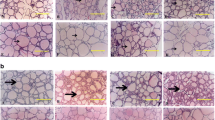Abstract
Fluoride balances were determined in nine children, aged 4 to 18 years, undergoing treatment with human growth hormone. Urinary F was increased in 6 of the 9 subjects during the period of initial treatment. The hyperfluoruria occurred in the face of a preexisting negative F balance. Fecal F did not change, and since the magnitude of the hyperfluoruria could not be correlated with changes in renal function it is likely that it, together with the increases in Ca and hydroxyproline excretion, represents a direct effect of the hormone (or possibly “sulfation factor”) on bone resorption. During the control periods, the F balance data reveal that 10–90% of dietary F (all of which came from food) appeared in the feces; these values are generally higher than those reported for subjects whose intake was primarily from water.
Résumé
Des bilans de fluor ont été réalisés chez neuf enfants, âgés 4 à 18 ans, soumis à un traitement à l’hormone de croissance humaine. Le F urinaire est augmenté chez 6 des 9 sujets pendant la période de traitement initial. L’hyperfluorurie s’observe au cours de la phase de bilan négatif en F. Le F fécal ne change pas et, étant donné que l’amplitude de l’hyperfluorurie ne parait pas liée à des modifications de la fonction rénale, il est vraisemblable qu’il s’agisse d’un effet direct de l’hormone (ou peut-être «du facteur de sulfatation») sur la résorption osseuse, ainsi que des augmentations en excrétions en Ca et en hydroxyleproline. Pendant les périodes de contrôle, les résultats de bilans en F montrent que 10–90% du F alimentaire apparait dans les fèces: ces valeurs sont généralement plus élevées que celles relevées chez des sujets où l’apport provient surtout de l’eau.
Zusammenfassung
Bei 9 Kindern zwischen 4 und 18 Jahren, welche menschliches Wachstumshormon erhielten, wurden die Fluoridbilanzen bestimmt. Das Fluorid im Urin war zu Beginn der Behandlung bei 6 von den 9 Kindern erhöht. Die Hyperfluorurie fand sich auch bei einer vorherigen negativen Fluorid-Bilanz. Der fäkale Fluoridgehalt veränderte sich nicht, und da die Höhe der Hyperfluorurie nicht mit Veränderungen der Nierenfunktion in Zusammenhang gebracht werden konnte, scheint es wahrscheinlich, daß die Hyperfluorurie, zusammen mit der erhöhten Calcium- und Hydroxyprolinausscheidung, eine direkte Wirkung des Hormons (oder möglicherweise des „Sulfation-Faktors”) auf die Knochenresorption darstellt. Die Fluorid-Bilanzdaten während der Kontrollperioden zeigen, daß 10–90% des eingenommenen Fluorids (ausschließlich aus der Nahrung stammend) in den Faeces erschienen; diese Werte sind allgemein höher als diejenigen von Personen, welche das Fluorid hauptsächlich in Wasser erhielten.
Similar content being viewed by others
References
Bryson, M. F., Forbes, G. B., Amirhakimi, G. H., Reina, J. C.: Metabolic response to growth hormone administration, with particular reference to the occurrence of hypercalcuria. Pediat. Res.6, 743–751 (1972).
Daughaday, W. H., Heins, J. N., Srivastava, L., Hammer, C. J.: Sulfation factor: studies of its removal from plasma and metabolic fate in cartilage. J. Lab. clin. Med.72, 803–812 (1968).
Daughaday, W. H., Kipnis, D. M.: The growth promoting and anti-insulin actions of somatotropin. Recent Progr. Hormone Res.22, 49–99 (1966).
Forbes, G. B., Bryson, M. F., Reina, J. C., Smith, F. A.: The metabolic response to growth hormone administration. Proc. 2nd Internat. Symp. Growth Hormone, p. 59–60. Milan: Excerpta Medica 1971.
Ham, M. P., Smith, M. D.: Fluorine balance studies on four infants. J. Nutr.53, 215–223 (1954a).
Ham, M. P., Smith, M. D.: Fluorine balance studies on three women. J. Nutr.53, 225–232 (1954b).
Henneman, P. H., Forbes, A. P., Moldawer, M., Dempsey, E. F., Carroll, E. L.: Effects of human growth hormone in man. J. clin. Invest.39, 1223–1238 (1960).
Largent, E. J.: Fluorosis. The health aspects of fluorine compounds, p. 30–31. Columbus, Ohio: Ohio State University Press 1961.
Machle, W., Scott, E. W., Largent, E. J.: The absorption and excretion of fluorides. Part 1. The normal fluoride balance. J. industr. Hyg.24, 199–204 (1942).
McClure, F. J., Mitchell, H. H., Hamilton, T. S., Kinser, C. A.: Balances of fluorine ingested from various sources in food and water by five young men. J. industr. Hyg.27, 159–170 (1945).
McConaghey, P. D., Sledge, C. B.: Production of “sulphation factor” by the perfused liver. Nature (Lond.)225, 1249–1250 (1970).
Prader, A., Zachmann, M., Poley, J. R., Illig, R.: The metabolic effect of a small uniform dose of human growth hormone in hypopituitary dwarfs and in control children. Acta endocr. (Kbh.)57, 115–128 (1968).
Prockop, D. J., Udenfriend, S.: A specific method for the analysis of hydroxyproline in tissues and urine. Analyt Biochem.1, 228–239 (1960).
Schwartz, E., Echemendia, E., Schiffer, M., Panariello, V. A.: Mechanism of estrogenic action in acromegaly. J. clin. Invest.48, 260–270 (1969).
Smith, F. A.: Metabolism of inorganic fluoride. In: Handbook of experimental pharmacology, vol. 20/1, ed. by Frank, A., Smith, p. 53–140. Berlin-Heidelberg-New York: Springer 1966.
Smith, F. A., Gardner, D. E.: The determination of fluoride in urine. Amer. industr. Hyg. Ass. Quart.16, 215–220 (1955).
Spencer, H., Osis, D., Wiatrowski, E., Samachson, J.: Availability of fluoride from fish protein concentrate and from sodium fluoride in man. J. Nutr.100, 1415–1424 (1970).
Author information
Authors and Affiliations
Rights and permissions
About this article
Cite this article
Forbes, G.B., Smith, F.A. & Bryson, M.F. Effect of growth hormone on fluoride balance. Calc. Tis Res. 11, 301–310 (1973). https://doi.org/10.1007/BF02547229
Received:
Accepted:
Issue Date:
DOI: https://doi.org/10.1007/BF02547229




